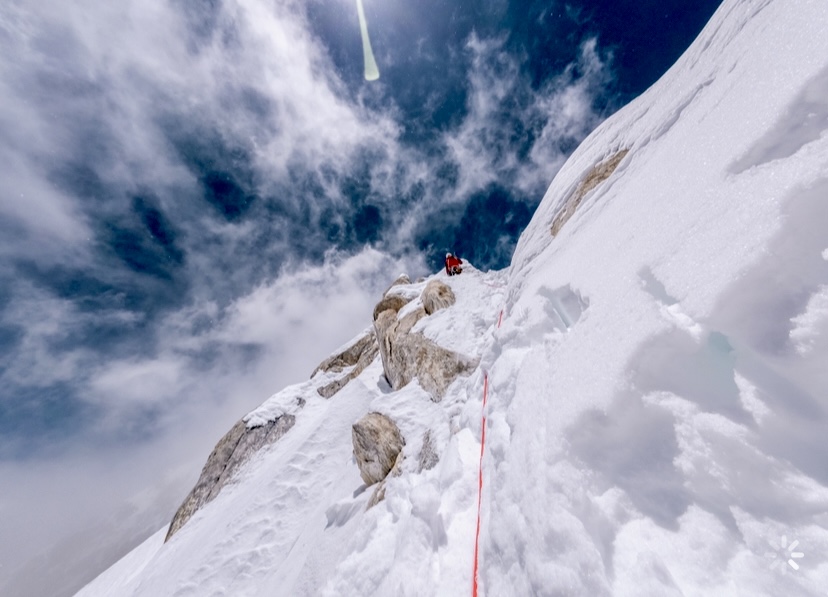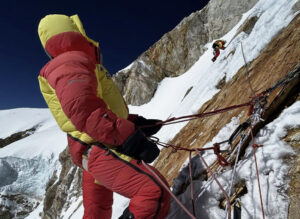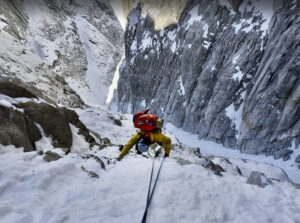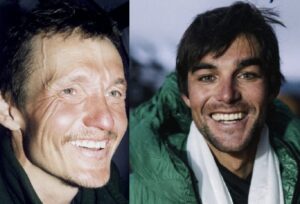From June 2-7, Mueez Ud Din of Pakistan and Mathieu Maynadier of France opened a new route on the previously unclimbed east ridge of 7,029m Spantik in the Karakoram.
A massive wind slab obstructed the climbers during the final part of the ascent, and they did not quite reach Spantik’s summit. Their GPS noted that they stopped at 6,999m.
The climbers named their new route Zindabad (“Long Live” in Urdu) and graded it 1,800m, M5, A1, 80°.

The new route on the east ridge of Spantik, with bivy sites marked. Photo: Mathieu Maynadier
The expedition included Maynadier (leader), Ud Din, videographer Nathanael Sapey, documentary filmmaker Loury Lagardere, drone manager Ozair Khan, and two cooks. During the approach, 42 porters supported them.
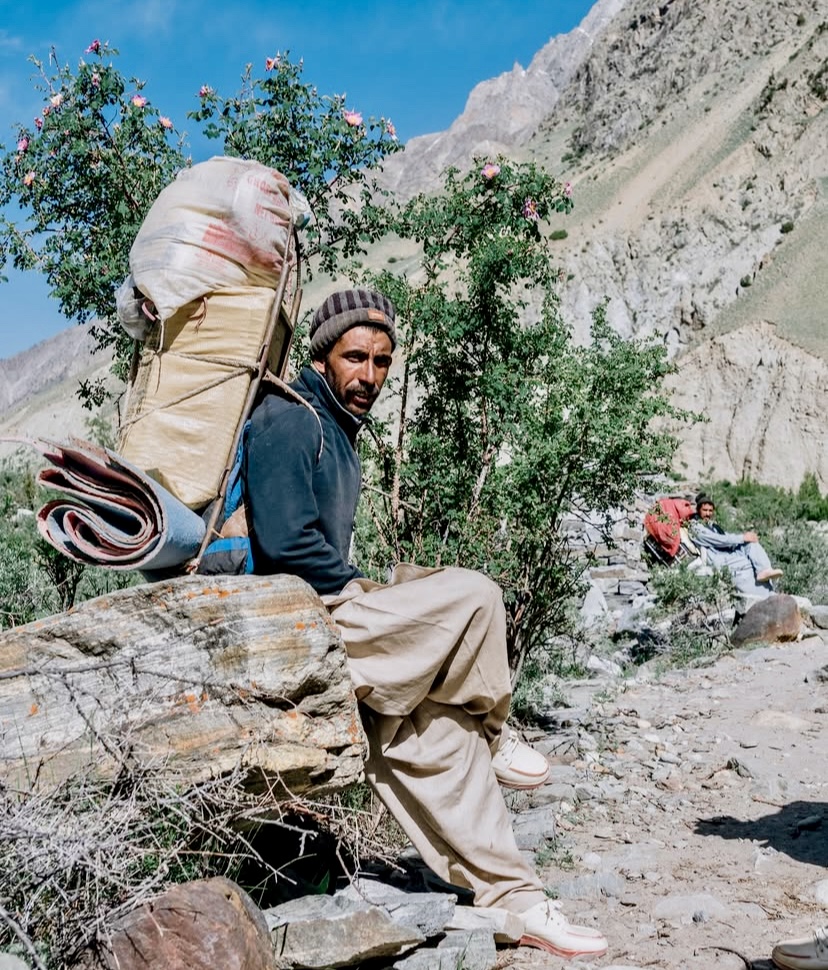
One of the porters during the approach trek to Spantik. Photo: Mueez Ud Din
The Spantik expedition almost didn’t happen because of recent Pakistan-India tensions. Many other planned expeditions pulled out, so that by May 20, Maynadier’s team may have been the only expedition in Skardu.
After a long drive, they reached Arandu, a small village in Baltistan’s Shigar Valley, near the confluence of the Shigar and Basha Rivers. The village serves as a gateway to Spantik’s base camp.
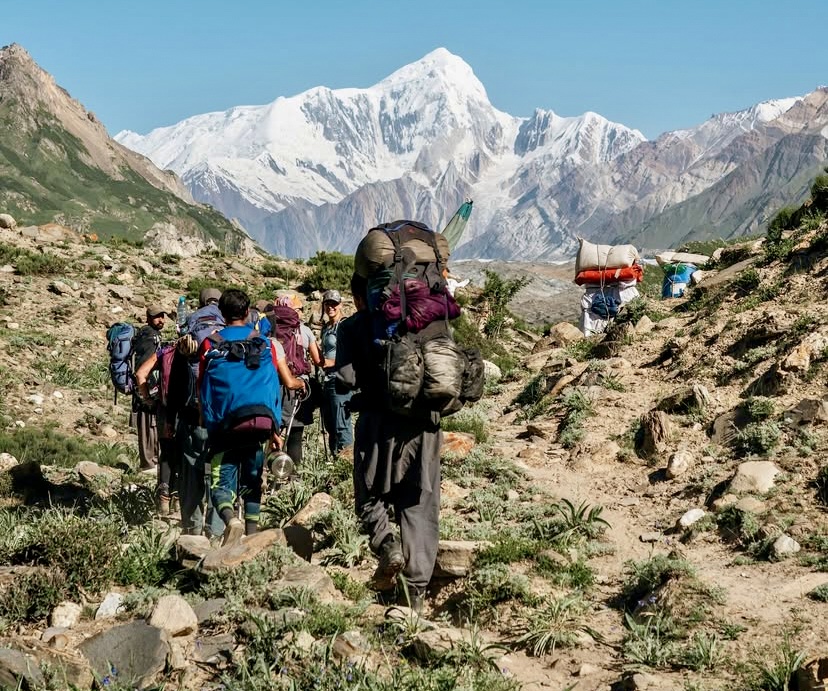
On the trek to Spantik base camp. Photo: Mathieu Maynadier
Tense moments during the approach trek
After three intense days of trekking and 35km of crevassed glacier, the party arrived at base camp on May 26.
The approach journey included a few tense moments, including when a porter fell between two icy walls. He was not injured, but the fall “sparked a brief rebellion among the group,” Maynadier wrote. “But after some negotiations, we were able to continue.”
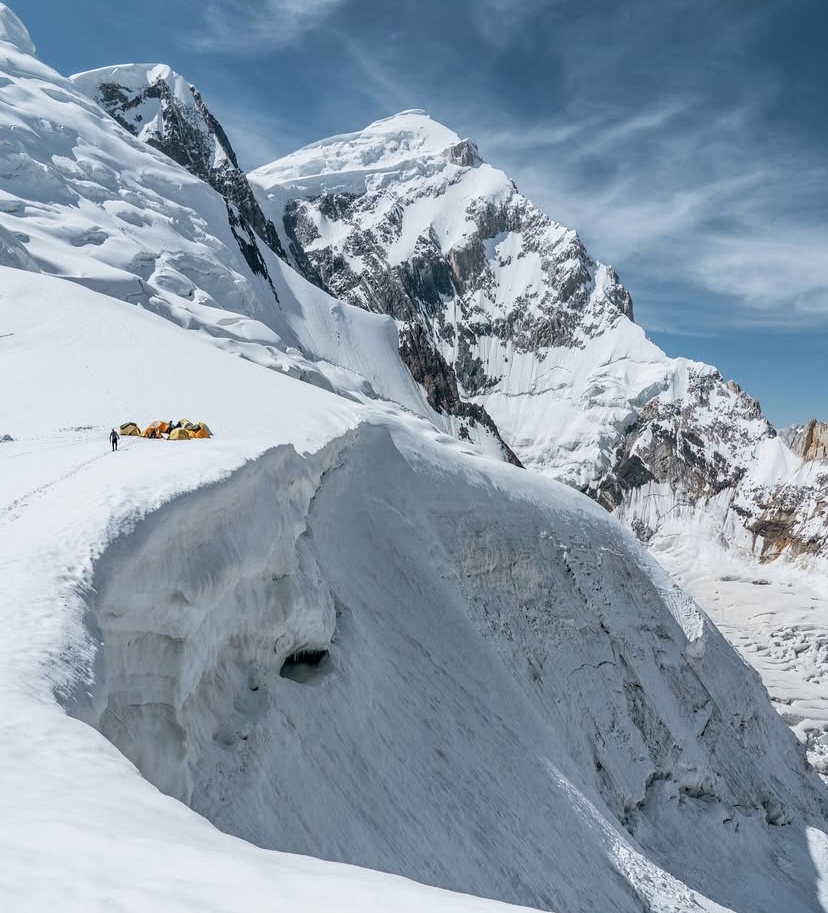
Photo: Mathieu Maynadier
Their acclimatization took two days. Seizing the first break in the weather, they spent two nights at higher elevations –- 5,200m and 5,800m –- on Spantik’s normal southeast ridge route. They then returned to base camp for a night’s rest on June 9.

During the first day of the climb. Photo: Mathieu Maynadier
The favorable weather persisted, and though not fully acclimatized, Ud Din and Maynadier pushed for the summit via the east ridge.
The climb
“We spent 25 days on the mountain, 10 of them at base camp waiting for a window that barely opened,” Ud Din wrote. “When it finally did, we went for it.”
The pair left base camp, situated above a heavily crevassed glacier at 4,200m, and ascended 1,800m over four days.
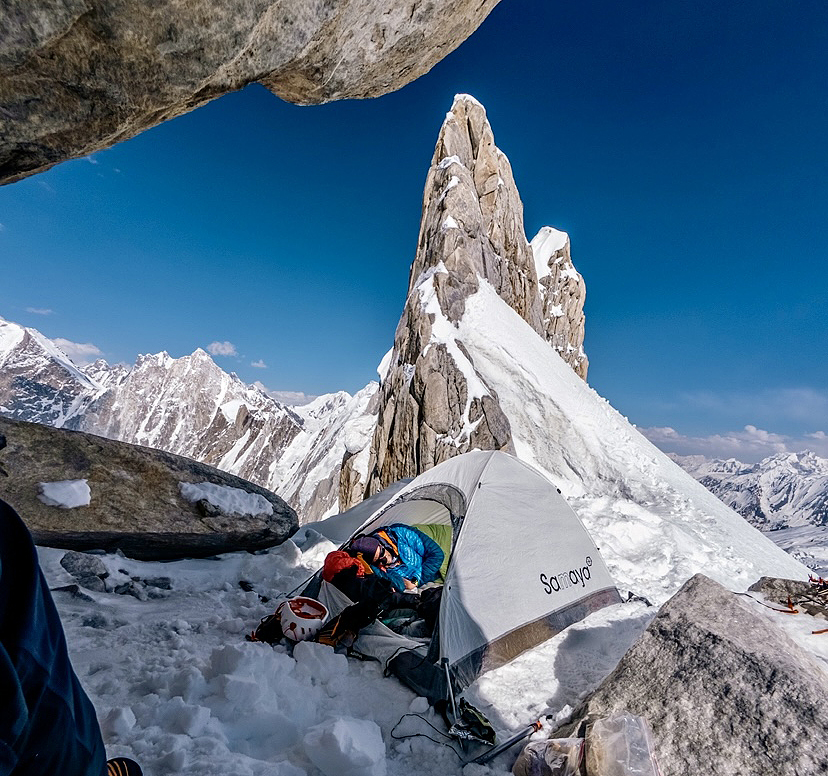
The picturesque bivy site at the end of the first day. Photo: Mathieu Maynadier
They crossed the bergschrund at 5,200m and eventually reached their highest point at 6,999m, just shy of the summit. There, a massive wind slab and dangerous amounts of snow blocked the final ridge.
“We made the tough call to turn back, but honestly, the route was the true summit,” Ud Din explained in a post.

Bivy protected by a huge rock. Photo: Mathieu Maynadier
The ascent required three bivouacs. Connecting their new line to Spantik’s normal route, they completed the descent with one bivouac at 5,800m. After a day and a half, the duo returned to base camp, five days after setting off.
Complex terrain and the crux
The long east ridge presented a complex tapestry of terrain, with snow sections and a mixed crux. As they gained altitude, the ridge sharpened into a knife-edge of snow and rock.
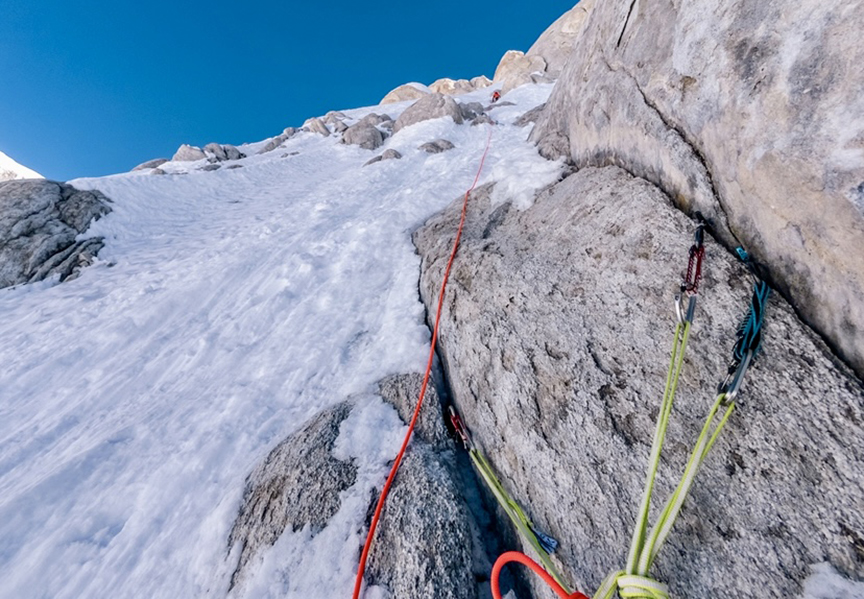
Climbing a steep section on the second day. Photo: Matheiu Maynadier
According to Maynadier, the crux arrived on the final day of the ascent: two mixed pitches rated M5, where ice-smeared granite demanded delicate footwork and precise axe placements. An A1 aid section required technical ingenuity to navigate overhanging rock.
“The higher you go, the steeper it gets,” Maynadier recalled. The ridge’s exposure, coupled with its technical demands, made every move a calculated risk.

Deep snow on the east ridge. Photo: Mathieu Maynadier
The first two days of the climb had clear skies, but conditions deteriorated on days three and four, as snow flurries dusted the ridge, obscuring holds and slowing progress.
The final bivouac at 6,700m was particularly tough, with 20cm of fresh snow blanketing their camp.
“It was a little stressful,” Maynadier admitted, recalling the tension of the wind howling all night and waking to a snow-laden tent.
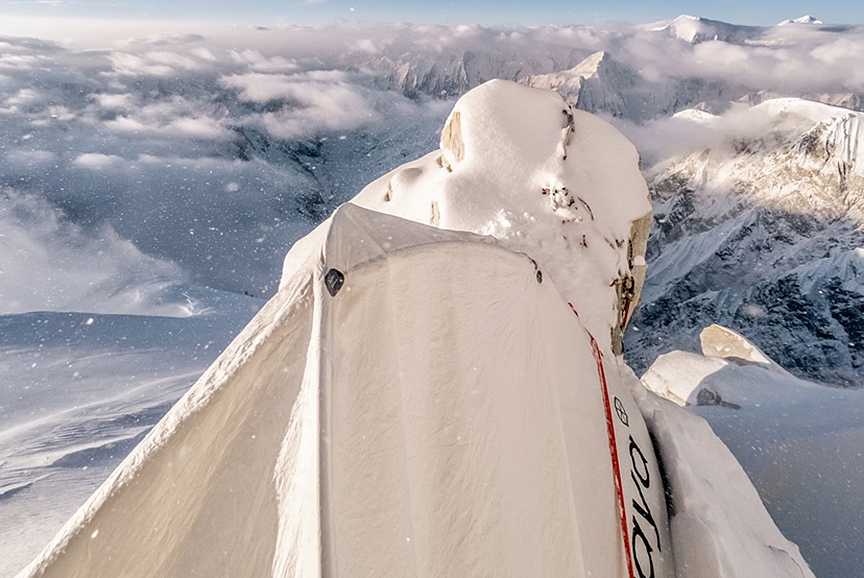
Unstable wind slab snow on the summit ridge. Photo: Mathieu Maynadier
But their commitment paid off. “After weeks in the Karakoram, we returned with more than just frostbite and memories,” Ud Din wrote on social media.
“We are happy. It’s a really cool line,” Maynadier told us.
Spantik’s storied past
First ascended in 1955 by a German expedition led by Karl Kramer via the southeast ridge, Spantik has long captivated climbers.
The southeast ridge was first attempted in 1906 by American explorers Fanny and William Bullock Workman, who reached 6,700m, a remarkable feat for the era. Subsequent milestones include the south ridge, climbed by a Japanese team in 1978, and the striking northwest pillar, ascended by British climbers Mick Fowler and Victor Saunders in 1987.
However, the east ridge remained untouched, its steep, exposed line deterring attempts until Maynadier and Ud Din’s bold climb. The American Alpine Journal records no prior ascents of this route.
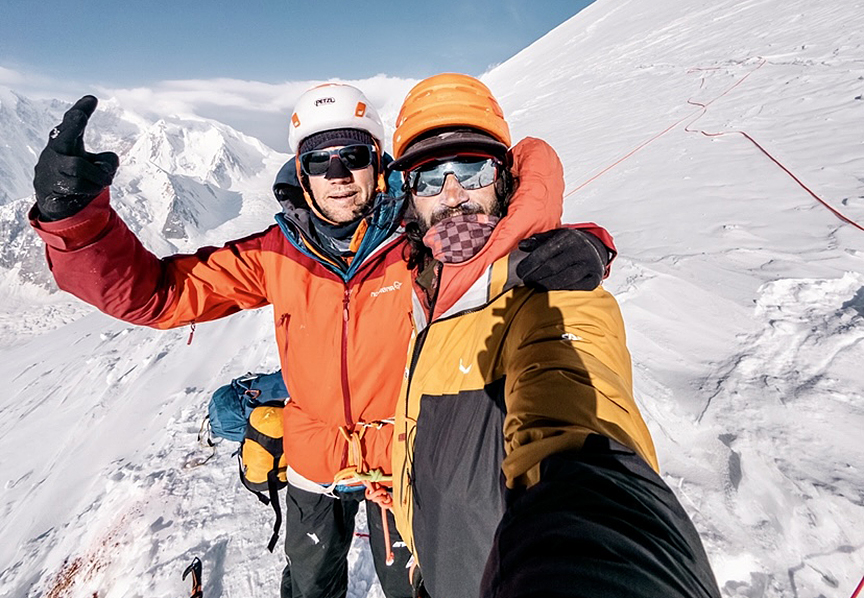
Maynadier, left, and Ud Din during the descent. Photo: Mathieu Maynadier
Unlike the guided, fixed-rope ascents common on Spantik’s more frequented routes, the duo’s approach aligns with the purist ethos of modern mountaineering. Their success not only adds a new chapter to Spantik’s legacy but highlights untapped potential.
Maynadier’s climbs
Maynadier, a 38-year-old French guide from Briançon, has a distinguished career of first ascents.
In 2010, Maynadier, Mathieu Detrie, Maxime Belleville, and Sebastien Ratel made the first ascent of 6,812m Lunag II in Nepal, via the southwest face. Their route, Close the Door (1,300m, ED), earned a 2011 Piolet d’Or nomination.
In 2012, Maynadier, Antoine Bletton, Pierre Labre, and Sebastien Ratel opened a new route on 7,108m Latok II in the Karakoram, reaching the southeast summit at 7,020m.
In 2013, Maynadier, Mathieu Detrie, Jerome Parra, and Pierre Labre carried out the first ascent of the south face of 7,134m Gaurishankar, by their new route Gare au Gauri (2,000m, ED+, M5/A1).
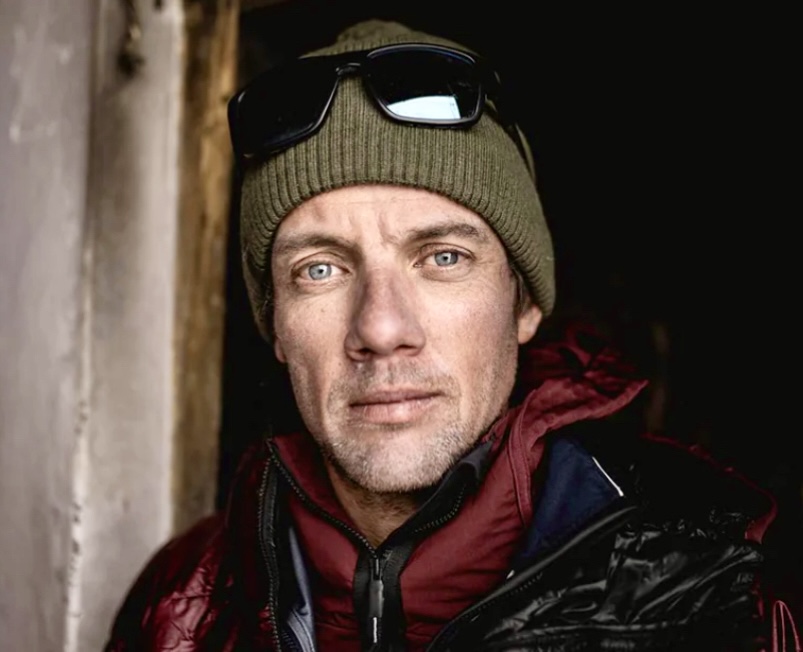
Mathieu Maynadier. Photo: Therm-ic.com
In the autumn of 2015, alongside Julian Dusserre, Maynadier opened the northeast face of 6,295m Dzasampatse in the Mahalangur Himal-Khumbu section of Nepal. Their 700m route was named A La Verticale de la Peine and graded TD+, WI5. They stopped 20m below the summit because of extremely unstable snow on the narrow ridge.
In 2017, Maynadier summited Gasherbrum II.

Maynadier wrapped in his sleeping bag on Spantik. Photo: Mueez Ud Din
A close call in 2018
In the summer of 2018, Maynadier, Nicolas Favresse, Jean-Louis Wertz, and Carlitos Molina were probably the first foreign mountaineers to explore the Tagas Valley in Pakistan’s Karakoram. They focused their attention on the west side of a beautiful rock tower near the Second Tagas Glacier, according to Favresse’s report for the American Alpine Journal. The summit, approaching 6,000m, was named Pathan Peak. On August 4, all four climbers reached the summit.
During the climb, right after Maynadier and Favresse had just completed fixing a new anchor, the ledge above them, on which Molina was standing, collapsed. Maynadier was hit and suffered a concussion, a fractured right elbow, and two compressed vertebrae. He was incoherent, but the team lowered him to a portaledge and called for rescue.
However, the next morning, Maynadier was in better shape and descended to the base of the wall. From there, an army helicopter evacuated him to Skardu.
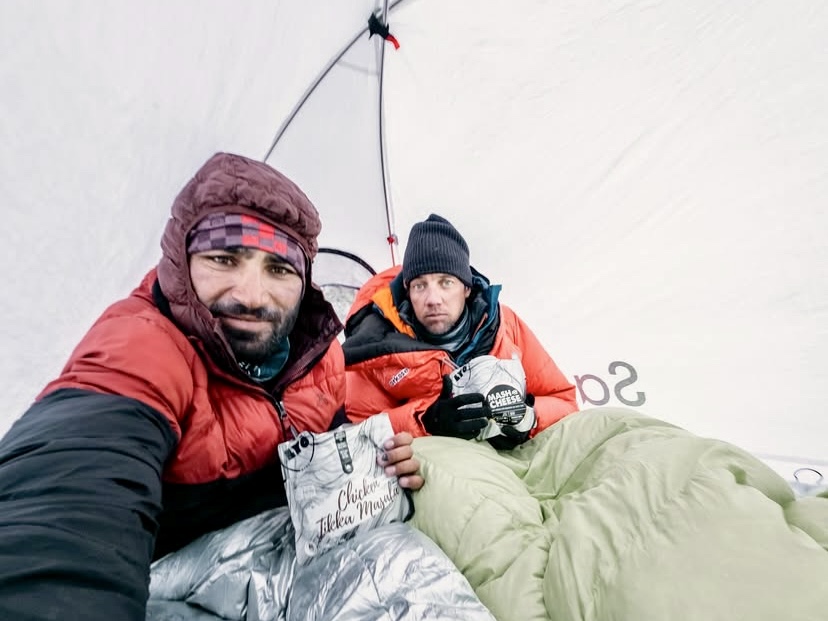
Ud Din, left, and Mathieu Maynadier at one of their bivy sites. Photo: Mueez Ud Din
In 2021, Maynadier and Tom Livingstone attempted 6,850m Pumari Chhish East, retreating just 100m from the summit after heavy snowfall.
The next year, Maynadier made the first ski descent of 7,266m Diran in the Karakoram, after reaching the summit at 6 pm.
In 2023, Maynadier, Simon Gietl, and Roger Schaeli opened Goldfish (800m, M6+, A1) on 6,570m Meru South’s southeast face in India.

Ud Din during the climb on Spantik. Photo: Mathieu Maynadier
Ud Din, an emerging talent
Muizz Ud Din, an emerging talent from Pakistan, represents a new generation of local mountaineers. Ud Din’s local knowledge and determination were critical to the expedition’s success.
His partnership with Maynadier is a bridge between global and local climbing communities, and their climb might be the first major new route opened in Pakistan by a local climber.
“It’s a huge step, I hope, for the Pakistan climbing community,” Maynadier said.
For Ud Din, Zindabad is more than a route. It’s a beacon for aspiring Pakistani climbers, proving that technical, high-altitude ascents are within their reach.
